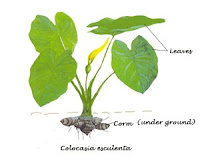
- The chickpea (Cicer arietinum), also known as Garbanzo Bean, Bengal Gram, Kabuli Chana, is an edible legume of the family Fabaceae, subfamily Faboideae. Chickpea is a highly nutritious pulse and places third in the importance list of the food legumes that are cultivated throughout the world.
- It contains 25% proteins, which is the maximum provided by any pulse and 60% carbohydrates.
- There are two main kinds of chickpea:
(1) Desi (meaning local in Hindi)is also known as Bengal Gram or Kala Chana. It has small, darker seeds and a rough coat, cultivated mostly in the Indian subcontinent, Ethiopia, Mexico and Iran. It is believed to have originated in Turkey.
(2) Kabuli (meaning from Kabul in Hindi) since they are thought to have come from Afghanistan when first seen in India, also known as Garbanzo Bean. It has lighter colored, larger seeds and a smoother coat, mainly grown in Southern Europe, Northern Africa, Afghanistan and Chile. It is also introduced during the 18th century to the Indian subcontinent
- Bengal Grams have markedly higher fiber content than Kabulis and hence a very low glycemic index which may make them suitable for people with blood sugar problems. It is used to make Chana Dal, which is a split chickpea with the skin removed.
- Chickpea is a helpful source of zinc, folate, and protein. They are also very high in dietary fiber and low in fat, most of which is polyunsaturated.
- Gram flour is flour made from ground Chana Dal. It is also known as chana flour (Indian), besan (Hindi), chickpea flour and garbanzo flour (Spanish).
























